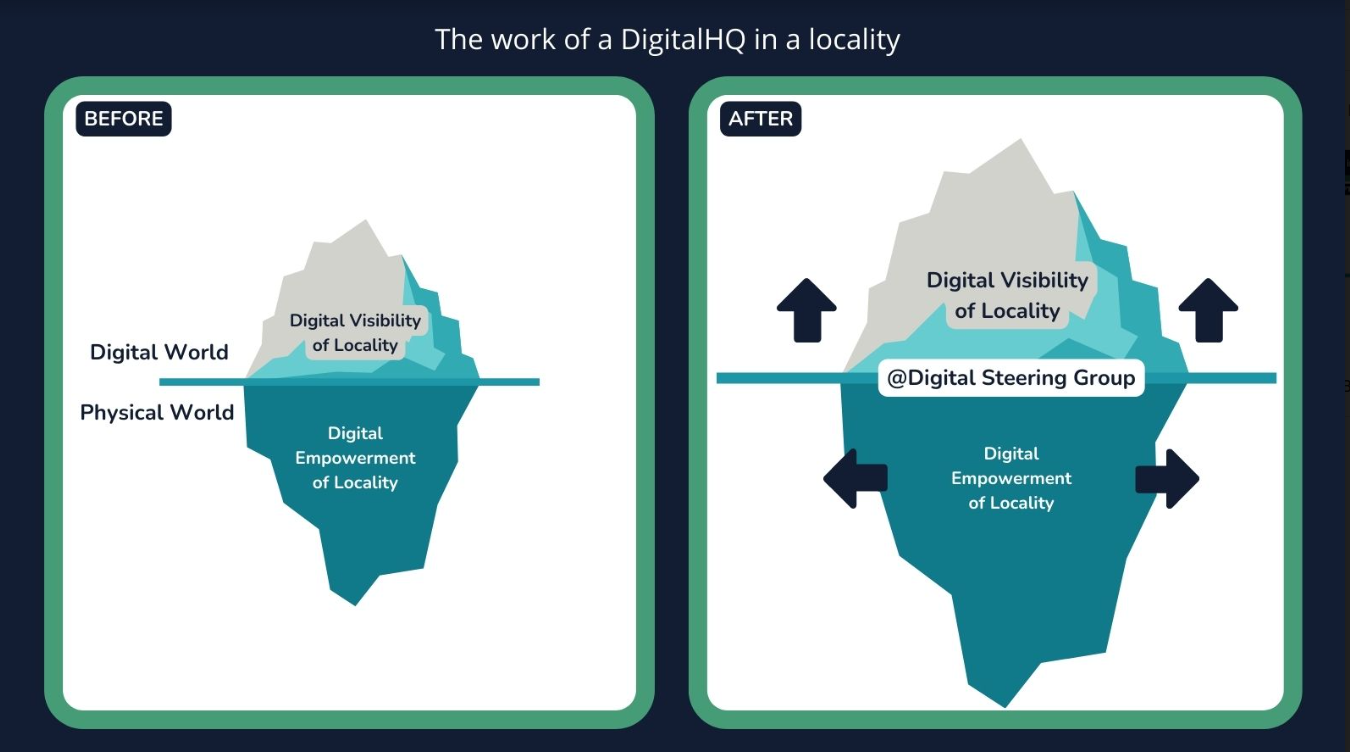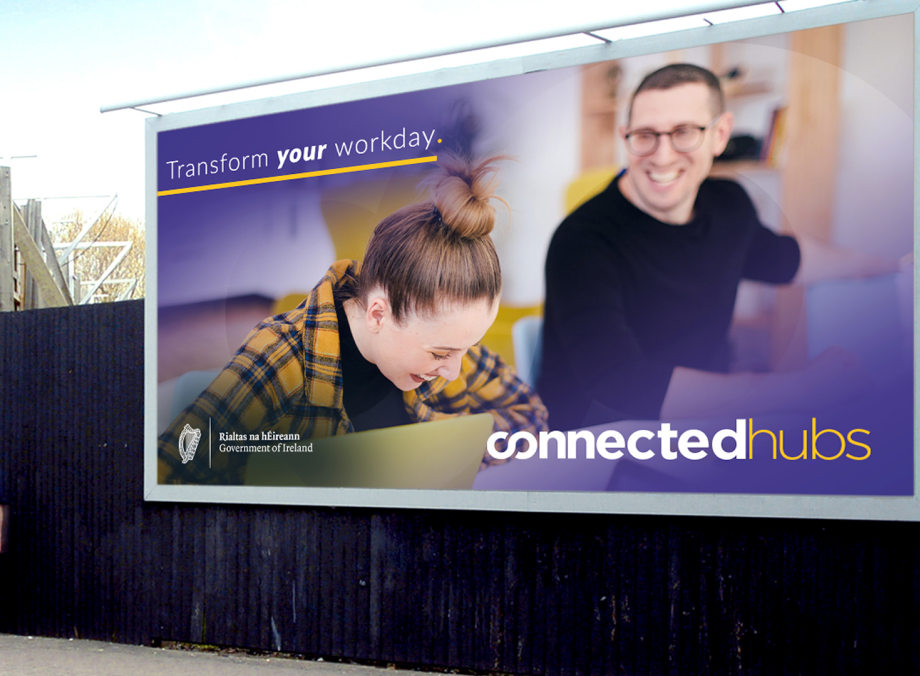Guest blog How Digital First Communities can repopulate rural Ireland and all through their local Connected Hub
29 August 2022
![]() By Unknown Author
By Unknown Author
We all know that the world is changing rapidly and that, at a time of major change, anything can be possible. However it is reasonable to ask if we can change a trend that is over 200 years in the making?
I’ll start exploring this challenge with two questions that you may already know the answer to:
- Which country’s economy is ranked by the OECD as one of the highest performing in the world but has a population now that is lower than it was 200 years ago?
- If Ireland was as densely populated as England is, what would its population be?
I pose these questions because we usually start assessing the possibilities of any particular course of action by reference to where we are now. The predominant narrative about how and where we live is that the future is all about megacities and any thinking to counteract this is first dismissed and then tends to be along the lines of ”if our goal is to repopulate rural Ireland we might achieve an incremental 5% here or 7% gain there”.
I believe that in the 21st century we can, and must, be far more ambitious in rebalancing the distribution of the population of our country. By way of challenging current perceived wisdom about rural repopulation the answer to 1 above is Ireland, in the early 1840’s our country’s population was 8.2 million. The answer to 2 is 35.5 million rather than the 5 million present in Ireland’s 2022 census (by the way I am not suggesting that 35.5 million should be a target for us).
So what’s DigitalHQ’s big idea?
Since the dawn of civilisation people gravitated in ever larger numbers to where the jobs were located. However, for many jobs, digital has now broken the link between physical place and the ability to be economically productive. Some experts predict (Reimagining Humanity) that this decoupling will see us moving towards a bottom up connected, creative society. They predict that strong participation in evolving networks will be critical for communities to thrive and participate in the emerging economic system of the 21st century. Through a myriad of digital empowered innovations, from 3D printing, remote work, vertical farms and solar/wind power (our cinema in Dun Laoghaire is converting its roof to become a solar farm!), rural communities will increasingly have the opportunity to become self organising and self sufficient.
Of equal importance is that digital is rapidly changing the nature of job creation. In the short term this is a skills question or as Ray Kurzwell suggests, “technology eliminates jobs at the bottom of the skill ladder and creates new ones at the top of the skill ladder.” In the medium term this is a question of where the jobs will come from in the coming era of jobless growth driven by the major tech companies. A case in point is Whatsapp which, when it was bought by Facebook in 2014 for approximately USD 16 billion with 450 million monthly users, it had a headcount of just 55 employees.

- "DigitalHQ believes that by 2030 social enterprise will become one of the largest creators of new, sustainable jobs in the Irish economy." -
The Government’s “National Social Enterprise Policy” envisages putting enterprises that are in the ‘business of social good’ centre stage in our economy over the coming decade. 2030 will see far more of us earning a living from social enterprises which will operate across a wide range of industrial sectors, with the most popular being social assistance, education and training, and work integration. The recent framing of the Government’s ‘Living Wage’ is a first step on this journey towards adapting to the changing nature of work available.
When it comes to social change at scale, as a country we have been here before. When Ireland joined the EEC in 1973 agriculture accounted for the employment of over one-quarter of the country’s total workforce, by 2020 this had fallen to 4.5% through mechanisation etc. So, somewhat like the large-scale movement from agricultural employment, Ireland now has two massive transitions to navigate simultaneously, the change in the nature of how we do our work and the change in the amount and nature of the work available!
- "We estimate that about half of all the activities people are paid to do in the world’s workforce could potentially be automated by adapting currently demonstrated technologies." McKinsey Global Institute -
Looking at the first transition - change in the nature of how we do our work
If you want a sense of where things are rapidly going watch Microsoft’s brief video ‘Here can be anywhere’. In the next five years digital will increasingly move from being a ‘behind the scenes’ enabler to creating what some experts call an ever present ‘digital twin’ online environment which mirrors our real world.
While the clunky nature of current versions of Metaverse might be underwhelming (the goofy avatar figures remind me of the first generation of computer games I played on the Sinclar computer as a kid in the 80s), keep in mind that, in their day, inventions like the telephone and personal computer were seen as curiosities until their potential was fully exploited.
- "The metaverse is a virtual world where humans, as avatars, interact with each other in a three dimensional space that mimics reality." Cambridge Dictionary 2022 -
Over the next 5 years attracting, creating and sustaining jobs in rural Ireland will require physical venues where access to the latest technologies and equipment and training for all in how to make the most of the new digital world is essential. In creating a model for this there is much that can be learnt from what Carnegie Libraries did for rural communities 100 years ago (more on this later).
In terms of the second transition - change in the amount and nature of the work available
Because it is people’s livelihoods we are dealing we, we need a way to enable a gradual process of changing at scale from traditional 20th century jobs to the roles and opportunities that the 21st century will create, doing this by facilitating a process of osmosis rather than a rapid ‘hand break’ turn. To create a catalyst for the repopulation of rural Ireland in the 21st century we need to think Carnegie Library + job reskilling + social enterprise creation hub all in one operating at the grassroots level.
This highlights the final element needed to embark on this transition, an organising framework that engages and makes people feel intrinsically motivated to get behind the rural repopulation initiative at all levels.
At DigitalHQ we call this framework ‘Digital First Communities’.
- "The real power of regeneration lies locally in communities where people live and work, it is based on pragmatism rather than ideology, action rather than obstruction." Bruce Katz on New Localism -
‘Digital First Communities’ - an organising model for 21st century Ireland
So if we were to seek to leverage the above two transitions to change 200 years of migration from rural Ireland where would we start? First we need to make the point to the doubters that such an ambition isn’t beyond us as a country. At a far less prosperous time our country undertook the electrification of rural Ireland which saw 1 million poles erected to carry 50,000 miles of cable to connect 300,000 homes.
An exciting vision for reimagining rural Ireland has been articulated in Minister Humphrey’s ‘Our Rural Future’ strategy. Government initiatives will certainly play their role in the ambitious project of repopulating rural Ireland, however the magic ingredient that makes the difference always comes down to local people with pride and passion for their place.
This is where digitalisation is different to electricity, electricity comes from a national network to power individual places and pieces of equipment whereas the most significant gains from digitalisation come from when the network is empowered transversely across different groups of people and activities coming together in a symbiotic whole.
We put this thinking into action to create our ‘Digital First Community’ in Dun Laoghaire. Over the past 6 years we have created a framework that uses digital growth for its prosperity by:
- Promoting and upskilling local businesses through what we call Love Dun Laoghaire campaigns.
- Converting vacant space in the town centre into the Dun Laoghaire Enterprise Centre.
- Bringing the town’s website and social media under the management of our social enterprise.
- Coordinating the input and drive of local stakeholders through our Digital Dun Laoghaire steering group.
In our ‘Digital First Communities’ framework the 3 Ps of marketing’s, product, place and promotion becomes People united behind their Place for its future Prosperity (and all through the smartphone in their pocket!).
However to get the real benefits of becoming a ‘Digital First Community’ and empowering a locality to take control of its economic destiny, a driver is needed on the ground with a physical presence and long term commitment to that place. This is where social enterprises like Digital HQ clg step up to advance the work of getting the benefits of being a ‘Digital First Community’ through their local hub.
- "This idea of the digital growth hub could take off and be a differentiator by being the flag waver for all things digital in our communities. There isn't a hub in the country that couldn't do without more income that they might get from delivering digitalisation training locally and in this work it's the mindset change that's needed rather than how to use tools." Manager of a ConnectedHub -
Digital HQ’s - The hub of a locality in the 21st century
Sustained social change at scale has always required a physical presence at the grassroots level. As part of rural electrification the ESB had retail outlets operating in many rural towns. Until the 2000s the ESB operated 100 shops across Ireland bringing the promotion of the practical use of electricity to localities across the country.

As mentioned earlier perhaps one of the most significant catalysts of social change, and a long standing institution in many rural localities, is the local Carnegie Library. Between 1886 and 1919, Andrew Carnegie donated today’s equivalent of $1.2 billion to fund the construction of more than 1,500 public libraries across the United States, 80 were funded in Ireland. Carnegie libraries were a new source of scientific, technical, and practical knowledge which became accessible to all citizens regardless of income or social status. Research has proven that in communities where a Carnegie library was located there was a tangible increase in innovation activity (as measured by patents) not just through the access to information but also the community-building mechanisms of the library.
A final part of the understanding of what will be needed as an enabler of the growth of rural localities in the 21st century is the role performed by the local post office. I grew up spending my summers in Waterford where my great aunts were post mistresses, one in Glencairn, the other in Tallow. Each day saw a constant stream of activity between the local people and the world at large through people posting, using the pay phone, paying and receiving money and also passing the time of day in animated conversation.
- "To have a local portal to the enablers of the 21st century, every high street in rural Ireland needs a digital hq, a hub for all things digital where locals and new arrivals can coalesce around the benefits of all that being a ‘Digital First Community’ offers." Eoin Costello, DigitalHQ -
As the national broadband plan connects more and more rural areas to high quality broadband a catalyst on the ground is essential to enabling localities to get the most from the ‘electricity’ of the 21st century. The prime candidate for this job is the local hub. As a result of the pandemic the concept of a coworking hub exploded into public consciousness. However for the traditional coworking hub the common experience is that it is difficult to make a typical co-working space financially sustainable due to the expectations of landlords, upward-only rent reviews and the covenants expected by property owners.
Reframing the concept of a Hub
Since its creation ConnectedHubs.ie, the flagship initiative of the Department of Rural & Community Development’s ‘Our Rural Future’ strategy, is making rapid progress in creating a shared infrastructure for hubs that will deliver real benefits across the country. Building on this success there is now the opportunity to reframe what a hub is about, a hub should provide office space but also be what its name suggests, a focal point around which a locality’s vibrant ‘Digital First Community’ can thrive in the 21st century.
Photo: The team from Fingal County Council's #SmartBalbriggan initiative on a fact-finding visit to Ireland's first DigitalHQ
where they met the Chair of our academy steering group and the Chair of our Living Lab steering group.
By embedding a digital hq within their hub, localities can mobilise around their economic development at scale in a sustained way with the hub being at the heart of this. The primary job of a digital hq is job creation and increasing job resilience.
Achieving this requires three key functions:
- Acting as the focal point - Coordinating and mobilising stakeholders through a @Digital steering group, increasing resilience by monitoring the mix of job creators (between B2C, B2B, Innovation Driven Enterprises and Social Enterprises) in the locality and seeking to fill vacant buildings with new remote worker friendly coworking spaces. At DigitalHQ we believe that by 2030 coworking will be the second highest use of formerly vacant space in our towns.
- Digital Visibility of the Locality - Just as digital marketing is a key function in any company or organisation to attract new customers and staff, the collective digital marketing of localities to attract investment, remote workers, home buyers, shoppers and visitors will become an essential role for a hub in the 21st century. The digital visibility of a locality will become increasingly important and includes factors such as its appearance in Google search, visibility of the locality’s hashtag in Twitter and Instagram, its presence in Wikipedia and Tripadvisor etc.
- Digital Empowerment - Digital visibility is directly linked to the level of digital skills and the effective use of digital tools that is taking place day to day in the locality. When people in a locality are ‘thinking digital first’ they act in a way that maximises the digital benefit of the things they do each day. Upskilling the different job creators (B2B, B2C, Innovation Driven Enterprises and Social Enterprises) in the locality, persuading and helping “old economy” SMEs across the country to adopt digital technologies and creating osmosis between the different cohorts is a key job for a digital hq.
- "Indeed, the digital imperative is made more urgent due to its interlinkages with our green ambitions, as highlighted in our Climage Action Plan 2021 - with digital technologies playing a key role in enabling the achievement of our climate targets." Ireland's National Digital Strategy 2022
Digital Ireland Network - together we are stronger
Imagine if increasing numbers of localities embrace the ‘Digital First Communities’ framework to capture the energy and commitment of all local stakeholders, how can we then knit them together to fashion a new model for rural economic development with the same momentum as the founding of the GAA, Tidy Towns or The Gathering.
Coordinated collaboration nationally and locally is needed to make the maximum progress in the shortest time therefore rather than using a trial and error approach established tools and best practices need to be leveraged to guide the work. Many communities are already interconnected via the ConnectedHubs network and this will be built on by the newly announced Digital Ireland Network. The jobs potential of such a network of can be seen from the 500 direct jobs and 1000 indirect jobs created via a sustainable digital economy for Skibbereen and the wider West Cork area that the Ludgate centre is creating.
- "Why should people who love the countryside have to live in big cities, something's wrong you know.” A Land Girl in 'A Canterbury Tale' 1944 -
Digital hq’s will not just connect rural communities to global opportunities but bring remote work opportunities to their doorstep thereby ushering in a new era of rural regeneration because in the 21st century with the climate crises, long commutes and other pressures it is definitely the case that 'small is beautiful' and the best 15 minute neighbourhood is that of a rural town or village with, thanks to broadband, equal access to many of the same opportunities as a city dweller.
Buckminster Fuller, the famous architect and visionary, talked about people’s reaction to the unfamiliar, to proposing changes to the status quo/dominant narrative, he observed that when we talk about what might be possible in the future it can be dismissed as ahead of its time. However he also noted the ease and speed with which the transformed reality once the change has happened as becoming so ‘natural’ as seeming to have been always obvious!
So here is to the goal of reversing Ireland’s rural depopulation, a trend that’s 200 years in the making which will be reversed in the 21st century.
Ambitious but not impossible and each of us can play our part through the smartphone in our pocket!
Eoin Costello
DigitalHQ clg
If you are interested in learning more about the benefits of becoming a ‘Digital First Community’ see our website - https://www.digital-ireland.ie/digital-first-communities/ or our video





